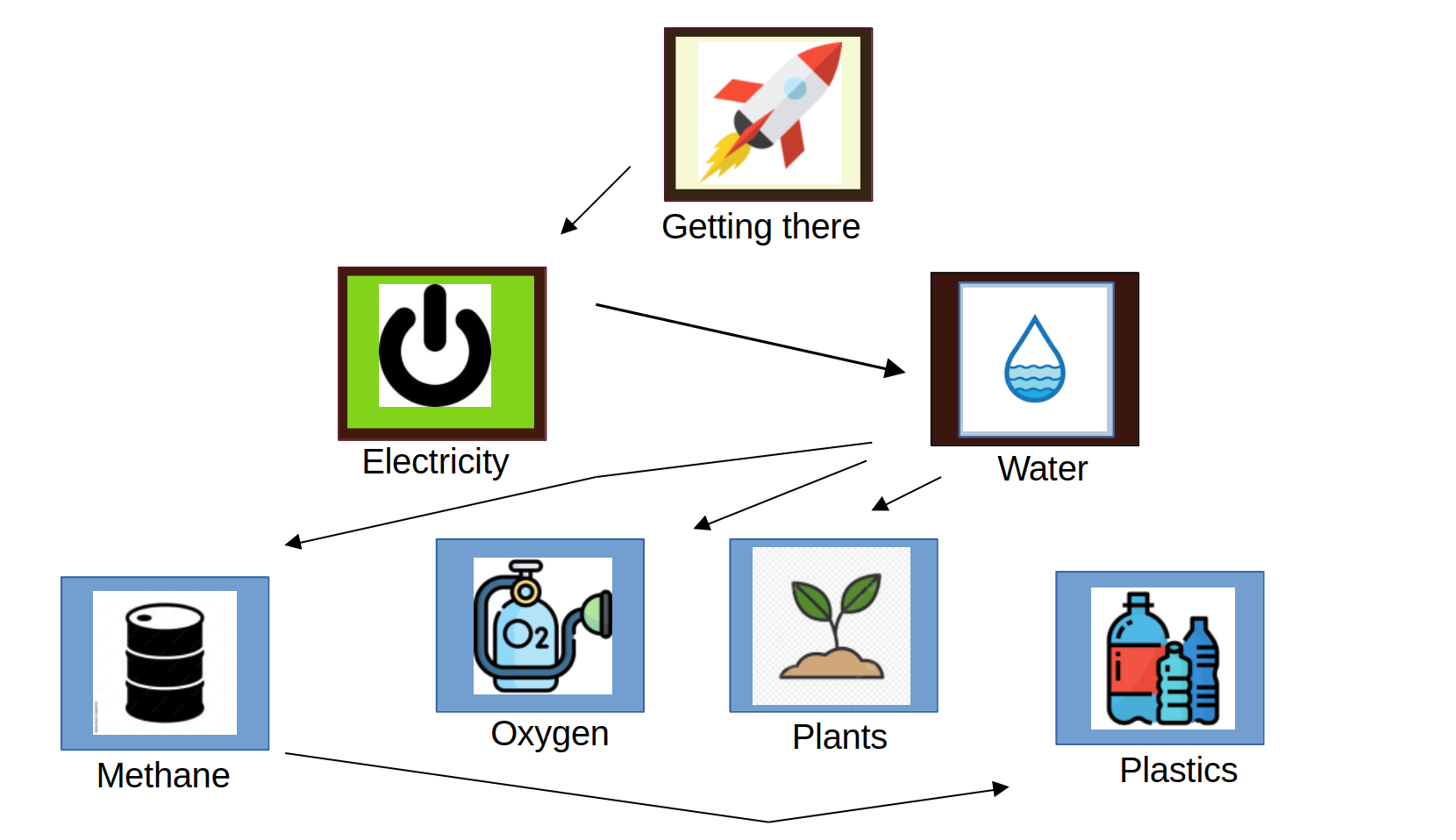from left to right:
- living inside the spaceship to reduce the need for construction/habitats
- solar panels (800 m² per person gives 80 kWpeak)
- bagger + furnace (not sketched) for excavating hydrated minerals and heating them in an oven to release water
- some greenhouses (recycled water for watering is displayed)
made with my newly acquired Gaomon drawing tablet + krita on linux :)
Yes! This is the kind of exhaustive thoroughness needed for planning an interplanetary colonization mission.
Oh i have more material than this about mars!
I’m thinking about opening a mars community here on lemmy to talk about settlement plans and scientific research on mars. i’ll probably do it when i get to it.
edit: !mars@discuss.tchncs.de
Mars Tech Tree diagram
I have made the following tech tree:
Stage 0: landing a rocket on mars
- you can re-use the rocket as a living habitat and stocked food for a while.
Stage 1:
- electricity : potentially through solar panels
- water : regolith evaporation and condensation
Stage 2:
- methane : including for fuel and energy-storage
- oxygen : for breathing, mostly, from the electrolysis of water
- plants : greenhouses need water, and humans need food.
- plastics : can be produced from methane by some organic chemistry tricks.
Stage 3:
- minerals : construction uses heavy stuff like metals, portland cement, ceramics, glass
- TBA
Visualization:

As always, your discussion is welcome.
-—
To explain why i set it up like this: water is important for a lot of things, but current water extraction proposals go into the direction of heating up regolith to release water vapor. That requires energy, which can be provided electrically.
Methane can store energy, but i’d like to store it away from the living habitats due to risk of leaks and explosions. I think the rocket that gets people there can be re-used as a living habitat, and its fuel tanks can be used to store oxygen for the winter and when the sun don’t shine.
Plastics can be made from methane with some organic chemistry tricks. I lack the wits to fully explain that, i hope you can forgive me.
After that, there’s still a lot of construction that needs to happen, to expand the base and build more houses for more people, including if people have babies. That will require some more substantial building than just some plastic greenhouse, and will be a mineral construction building. It’s not on the diagram above due to lack of space, but you gotta imagine it. Cheers!
i wrote this a while ago on reddit (/r/MarsSociety) but reddit kinda sucks and i’m thinking about shifting the materials here.
[discussion] early mission structure
So, what will an early human mars mission look like?
I want to muse a bit about this:
- Human marsflight is expensive. The rocket equation means it’s exponentially more difficult the more acceleration/landing you do. That is why reaching mars is reachable with a single rocket, but returning with the same rocket requires fuel production on Mars to refill the rocket.
- Creating 1000 m³ of cryogenic fuel on Mars is really challenging and definitely not something that the first settlers will be able to pull off. Reasons include: Huge resource requirements, but more urgently, that all the cryogenic fuel has to be produced at once. If it is produced slowly, over the course of many months, then the cryogenic fuel warms up and evaporates before it can be used.
- Therefore i expect the first settlers to spend a longer time on Mars before they will be able to return. I’d like to assume they’d spend at least 10 years on Mars.
- So, what does their daily lifes look like?
- They need water, food, and electricity. I think it makes sense to produce electricity first (through solar panels because they offer the most average power per kg transported to mars), then water by baking regolith in a furnace (studies such as this one discuss this, the furnace needs electricity to work), then doing electrolysis of water to produce oxygen, then building greenhouses for food.
- It is better to deploy teams of 2 people to do each task. Alone, people become lonely and depressed, and there’s also an added security perspective when using 2 people for each task. When there’s an unexpected difficulty or malfunction that puts 1 person out of use (such as oxygen leaks that cause unconsciousness or accidents that knock somebody out), then the other person can immediately respond to that and acquire help.
- I propose early missions to consist of 8 people per ship. Assuming the ships have a carrying capacity of at least 80 t to Mars, that means a capacity of 10 t per person for supplies and devices. Split into pairs of 2, that makes 4 teams to do tasks. One team would need to provision electricity by expanding the solar park and maybe taking care of dust and other defects, one team would need to provide water by refilling the ovens with regolith, and another 2 teams can do other things, such as research into the martian landscape (areology, mineral mapping) or construction.
Let me hear from you! A community lives through its discussions.
Gotta design the spaceship to be expanding like those fancy RVs.
I like how detailed the textures are


